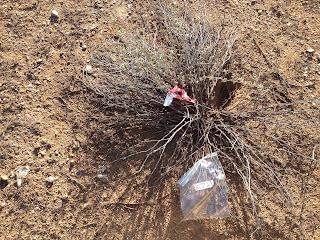The Sonoran Desert in and around Phoenix, AZ is changing in a lot of ways. There is rapid urbanization, thanks to the large and growing population of the Phoenix metropolitan area. That means lots of construction, concrete, invasive species, habitat fragmentation, and all of the other things that come with dense human populations!
Those humans also drive a lot of cars and burn a lot of fossil fuels. One problem tied to that is the release of nitrogen pollution into the atmosphere, which eventually drops onto the soil. Nitrogen is a nutrient that all organisms need to survive, but too much can start to become a problem. (Just think of carbs in a human diet. We need some, but too much is unhealthy!) That extra nitrogen becomes a form of pollution that can harm the environment.
Also, you probably already know that burning fossil fuels puts excess CO2 into the atmosphere, which causes our planet’s climate to change. Warmer temperatures is the most publicized impact, but it’s not just about a hotter planet. In fact, in the Sonoran Desert, where the native organisms are already adapted to extreme heat, a couple degrees of warming may not be the hardest part of climate change to deal with. Another part of climate change that could be very important for the Sonoran Desert is the change in rainfall that accompanies the changes in atmospheric air circulation from warmer temperatures. The predictions for this area are that there will be less frequent but bigger rain storms, with overall less rain falling every year. That’s very difficult for plants and animals who are already so water limited in the desert!
A lot of scientists have studied the impact of urbanization, nitrogen pollution, warmer temperatures, or changes in rainfall on ecosystems. But typically they are studied independently, just one change at a time. In the real world, though, these things are happening all at once! The Sonoran Desert organisms don’t get to deal with just urbanization OR warmer temperatures. They have to deal with the pollution, temperatures, rainfall, AND all of the things that come with urbanization, all together. How will they respond?
To answer this question, we set up a lab experiment. It’s hard to separate all of these changes in the field, because they’re already happening! We can study how the soil responds more easily in the lab, where we can turn each of the changes on and off. To do this, we created tiny Sonoran Desert “microcosms” in little vials. They are filled with soil from urban soils inside Phoenix or soils from parks outside the city.
We then created all of the changes that the Sonoran Desert is experiencing. The jars were kept at either regular temperatures, or 2 degrees warmer. Some received nitrogen pollution and some did not. They were given rainfall at either normal amounts and frequency, or larger rainstorms and less frequent rainstorms. We made all of the changes happen at once, to see how the soils responded to each combination of changes.
The machine next to the tray of vials is how we measured respiration in each of the vials. We use a syringe to remove the air from the vials, and the machine tells us how much CO2 was respired by the soil microbes.
While the soil microbes are busy being active and respiring, they are also processing nutrients in the soil. Their activity is how nutrients get recycled and become available for plants to grow. So, we also measured the nutrients in the soil inside our vials.The results of this study are published in: Williamson, M., B.A. Ball. 2023. Soil biogeochemical responses to multiple co-occurring forms of human-induced environmental change. Oecologia 201: 1109-1121. doi: 10.1007/s00442-023-05360-7




























